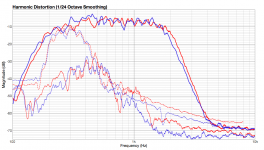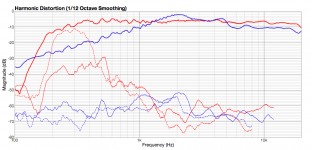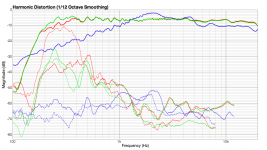Agreed. It's not like the Neo3 really has any competition since it clobbers other planars on distortion, low frequency reach, and beats most of them on price.
So which one are you using, the PDR or non-PDR? I've had the PDR for a few months now, and I'm thinking of trying the non-PDR. Several people have measured it and come to essentially the same conclusion, that the 7kHz null is less prominent, and the driver beaming isn't as bad as EDGE predicts.
I read the same threads, reached the same conclusion, and bought the non-PDRs a few months ago. Weather hasn't cooperated for taking my own set of polars though. In the tweeter range I find I get adequate SPL accuracy indoors. But I'm more interested in phase and nonlinear distortion; getting good data for those seems to require outdoor measurements with the right combination of light wind, little background noise, no precipitation, and no ice or old snow.
I'm sorry, but I have to get back to the midrange distortion issue - and I have to backtrack again. (Only to be excused by my being an absolute beginner. Or at least I hope so...)
I measured my other drivers under the same conditions, and - surprise! - they all exhibit the same behaviour: A clearly audible rasping noise in the lower mids. So I guess it's not the W4-1320, after all.
Doing a sine sweep with the Tangband and the SEAS L16, I got an almost perfect match on the 3rd harmonic distortion values (TB red, SEAS blue):

And 2nd order distortion seems quite similar, too.
Since this is clearly confirmed by my ears (and almost every impact from mounting etc. has been ruled out), the problem really seems to lie with my playback electronics - MBP output, i|o2, DCX, Rotel amp or the wiring.
I tried to nail things down by using a test tone generator, and what I found is that the distortion is only audible for a very short time when playing the tone, then the sound becomes smooth as a sine can be. At lower SPLs, the effect doesn't come into play at all.
Again, this probably points to a problem with my playback setup - the exact source, though, remains mysterious to me.
I'm grateful for any hints on this - in the meantime, I'll continue my efforts with measuring at lower SPLs.
Thanks for your attention, insights and patience!
I measured my other drivers under the same conditions, and - surprise! - they all exhibit the same behaviour: A clearly audible rasping noise in the lower mids. So I guess it's not the W4-1320, after all.
Doing a sine sweep with the Tangband and the SEAS L16, I got an almost perfect match on the 3rd harmonic distortion values (TB red, SEAS blue):

And 2nd order distortion seems quite similar, too.
Since this is clearly confirmed by my ears (and almost every impact from mounting etc. has been ruled out), the problem really seems to lie with my playback electronics - MBP output, i|o2, DCX, Rotel amp or the wiring.
I tried to nail things down by using a test tone generator, and what I found is that the distortion is only audible for a very short time when playing the tone, then the sound becomes smooth as a sine can be. At lower SPLs, the effect doesn't come into play at all.
Again, this probably points to a problem with my playback setup - the exact source, though, remains mysterious to me.
I'm grateful for any hints on this - in the meantime, I'll continue my efforts with measuring at lower SPLs.
Thanks for your attention, insights and patience!
To me it seems like the obvious extension of the debugging techniques we were discussing earlier would be to feed the tone generator directly to the Rotel, listen for the rasp, and---if you need to---keep adding stuff until the problem shows up again.
Debugging, continued
Not having much time on my hands at the moment, it took some time to go through (some of) the debugging steps. (Thanks, twest820 and cuibono, for providing such good guidance!)
First, I made sure that there weren't any loose screws or other mechanical sources of distress. I rearranged the drivers on a new rig (microphone stand), redid and checked all the driver mountings and took a close look at the cable connections. Then I went about taking measurements and listening tests in different equipment setups.
Results so far are: The io|2 doesn't seem to be the problem, since distortion is the same with test tones played through AirTunes. Test tones played from my CD player suggest (though not measured) that on the one hand there are playback issues (sines played from my MBP do contain flaws), and on the other hand there may be a severe problem with my DCX.
Playing test tones at high levels with the DCX active always results in un-sine-like sounds (stuttering, rasping and the like). Closely watching the DCX's LEDs, I finally became aware of its reaching clipping/limit levels on the test tones everytime I encountered the irregularities. (Sorry for not having paid attention to that earlier...)
Comparing measurements with and without the DCX seems to corroborate this guess (red: with, blue: w/o DCX; thick line FR, thin lines distortion).

So at the moment, I guess that the DCX running into its level limits may be the main problem. Has anyone encountered similar problems? And how can I avoid running into its limits - not playing unusually loud sounds, anyway?
Not having much time on my hands at the moment, it took some time to go through (some of) the debugging steps. (Thanks, twest820 and cuibono, for providing such good guidance!)
First, I made sure that there weren't any loose screws or other mechanical sources of distress. I rearranged the drivers on a new rig (microphone stand), redid and checked all the driver mountings and took a close look at the cable connections. Then I went about taking measurements and listening tests in different equipment setups.
Results so far are: The io|2 doesn't seem to be the problem, since distortion is the same with test tones played through AirTunes. Test tones played from my CD player suggest (though not measured) that on the one hand there are playback issues (sines played from my MBP do contain flaws), and on the other hand there may be a severe problem with my DCX.
Playing test tones at high levels with the DCX active always results in un-sine-like sounds (stuttering, rasping and the like). Closely watching the DCX's LEDs, I finally became aware of its reaching clipping/limit levels on the test tones everytime I encountered the irregularities. (Sorry for not having paid attention to that earlier...)
Comparing measurements with and without the DCX seems to corroborate this guess (red: with, blue: w/o DCX; thick line FR, thin lines distortion).

So at the moment, I guess that the DCX running into its level limits may be the main problem. Has anyone encountered similar problems? And how can I avoid running into its limits - not playing unusually loud sounds, anyway?
I've hit the same thing in my PC crossover, but it took about 40dB of dipole compensation to induce clipping. Whereas, if the two curves are taken with the same levels, your data indicates the DCX starts clipping just about as soon as any gain is applied.
Are you still observing that the distortion quickly goes away? If so, the first thing I'd check would be the dynamic EQ settings. Also, what are the input levels to the DCX and what are the gain settings on that input and the output channel you're using?
Are you still observing that the distortion quickly goes away? If so, the first thing I'd check would be the dynamic EQ settings. Also, what are the input levels to the DCX and what are the gain settings on that input and the output channel you're using?
This is weird. I'll have to check, but I don't think I've run into this with my DCX. I do sometimes hear stuttering, but I always assumed that was my old laptop, because it usually happens the first time I fire up HOLM or REW, and it's not repeatable. I don't think I've pushed the signal levels very much. I'll have to keep an eye on the LEDs next time I'm taking measurements.
I'm sorry I'm going through such small iterations, but: I think I've at least (and finally) found the cause for the predominant anomaly in my recent measurements. I haven't gathered more specific data about input/output levels on my DCX yet, but I've played with input levels until they were below clipping. And, alas, results are looking much more acceptable:

Red and blue are the measurements from last time, with and without DCX, respectively. Green is the measurement taken with lower input to the DCX, levels matched by pushing the amp instead. (XO 200 Hz and 1.8 kHz, LR4 as usual.)
The insane rise in 3rd harmonics is gone, and the remaining distortion seems to be much more reasonable - and easier to handle, too. The peak below 300Hz is being accommodated by my targeted XO at 290 Hz, and above that, distortion falls well below 3% when I turn down SPL to about 80 dB.
So, I think what I see now is the real behaviour of the TB. Playing some more with gain levels didn't show any qualitative change, only gradual (and probably expected) changes in distortion magnitude.
(And my hearing the distortion only at the beginning of the sine sweep seems to fit well with the DCX being obviously unable to handle the dipole roll-off compensation - in my case: 28 dB lift - when run at clipping levels.)
Again: Thanks for all your helpful insights & hints!

Red and blue are the measurements from last time, with and without DCX, respectively. Green is the measurement taken with lower input to the DCX, levels matched by pushing the amp instead. (XO 200 Hz and 1.8 kHz, LR4 as usual.)
The insane rise in 3rd harmonics is gone, and the remaining distortion seems to be much more reasonable - and easier to handle, too. The peak below 300Hz is being accommodated by my targeted XO at 290 Hz, and above that, distortion falls well below 3% when I turn down SPL to about 80 dB.
So, I think what I see now is the real behaviour of the TB. Playing some more with gain levels didn't show any qualitative change, only gradual (and probably expected) changes in distortion magnitude.
(And my hearing the distortion only at the beginning of the sine sweep seems to fit well with the DCX being obviously unable to handle the dipole roll-off compensation - in my case: 28 dB lift - when run at clipping levels.)
Again: Thanks for all your helpful insights & hints!
- Status
- Not open for further replies.
- Home
- Loudspeakers
- Multi-Way
- Driver evaluation for OB project